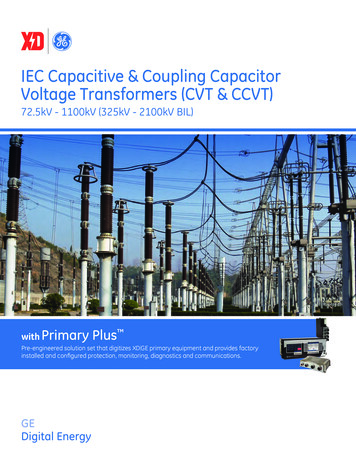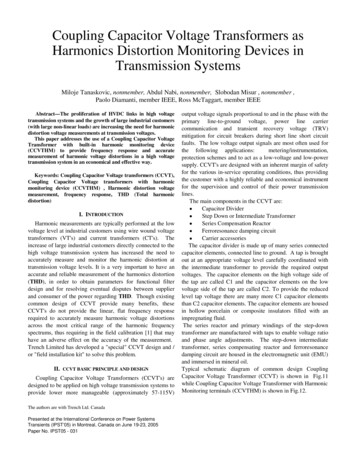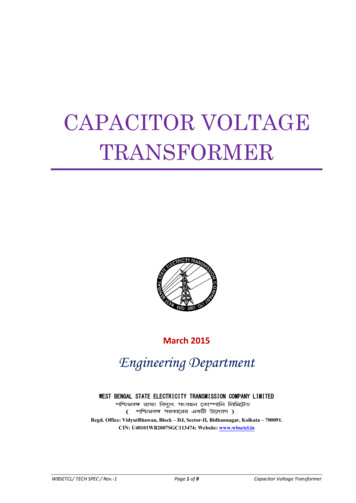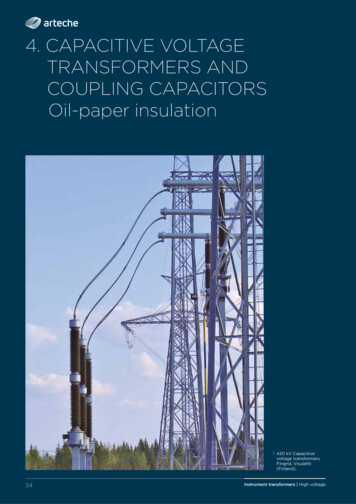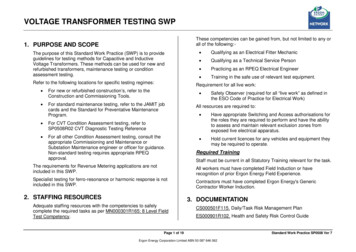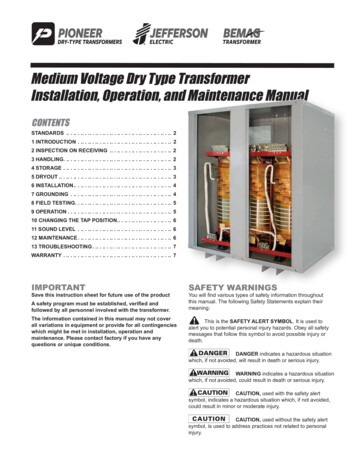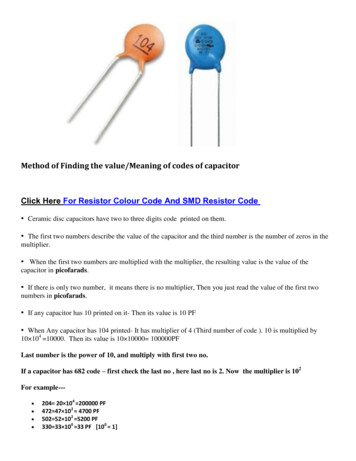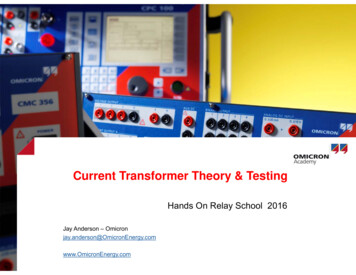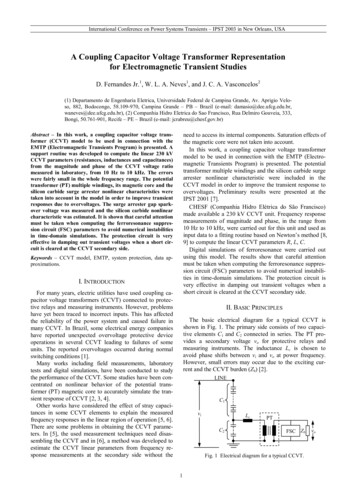
Transcription
International Conference on Power Systems Transients – IPST 2003 in New Orleans, USAA Coupling Capacitor Voltage Transformer Representationfor Electromagnetic Transient StudiesD. Fernandes Jr.1, W. L. A. Neves1, and J. C. A. Vasconcelos2(1) Departamento de Engenharia Eletrica, Universidade Federal de Campina Grande, Av. Aprigio Veloso, 882, Bodocongo, 58.109-970, Campina Grande – PB – Brazil (e-mail: damasio@dee.ufcg.edu.br,waneves@dee.ufcg.edu.br), (2) Companhia Hidro Eletrica do Sao Francisco, Rua Delmiro Gouveia, 333,Bongi, 50.761-901, Recife – PE – Brazil (e-mail: jcrabreu@chesf.gov.br)need to access its internal components. Saturation effects ofthe magnetic core were not taken into account.In this work, a coupling capacitor voltage transformermodel to be used in connection with the EMTP (Electromagnetic Transients Program) is presented. The potentialtransformer multiple windings and the silicon carbide surgearrester nonlinear characteristic were included in theCCVT model in order to improve the transient response toovervoltages. Preliminary results were presented at theIPST 2001 [7].CHESF (Companhia Hidro Elétrica do São Francisco)made available a 230 kV CCVT unit. Frequency responsemeasurements of magnitude and phase, in the range from10 Hz to 10 kHz, were carried out for this unit and used asinput data to a fitting routine based on Newton’s method [8,9] to compute the linear CCVT parameters R, L, C.Digital simulations of ferroresonance were carried outusing this model. The results show that careful attentionmust be taken when computing the ferroresonance suppression circuit (FSC) parameters to avoid numerical instabilities in time-domain simulations. The protection circuit isvery effective in damping out transient voltages when ashort circuit is cleared at the CCVT secondary side.Abstract – In this work, a coupling capacitor voltage transformer (CCVT) model to be used in connection with theEMTP (Electromagnetic Transients Program) is presented. Asupport routine was developed to compute the linear 230 kVCCVT parameters (resistances, inductances and capacitances)from the magnitude and phase of the CCVT voltage ratiomeasured in laboratory, from 10 Hz to 10 kHz. The errorswere fairly small in the whole frequency range. The potentialtransformer (PT) multiple windings, its magnetic core and thesilicon carbide surge arrester nonlinear characteristics weretaken into account in the model in order to improve transientresponses due to overvoltages. The surge arrester gap sparkover voltage was measured and the silicon carbide nonlinearcharacteristic was estimated. It is shown that careful attentionmust be taken when computing the ferroresonance suppression circuit (FSC) parameters to avoid numerical instabilitiesin time-domain simulations. The protection circuit is veryeffective in damping out transient voltages when a short circuit is cleared at the CCVT secondary side.Keywords – CCVT model, EMTP, system protection, data approximations.I. INTRODUCTIONFor many years, electric utilities have used coupling capacitor voltage transformers (CCVT) connected to protective relays and measuring instruments. However, problemshave yet been traced to incorrect inputs. This has affectedthe reliability of the power system and caused failure inmany CCVT. In Brazil, some electrical energy companieshave reported unexpected overvoltage protective deviceoperations in several CCVT leading to failures of someunits. The reported overvoltages occurred during normalswitching conditions [1].Many works including field measurements, laboratorytests and digital simulations, have been conducted to studythe performance of the CCVT. Some studies have been concentrated on nonlinear behavior of the potential transformer (PT) magnetic core to accurately simulate the transient response of CCVT [2, 3, 4].Other works have considered the effect of stray capacitances in some CCVT elements to explain the measuredfrequency responses in the linear region of operation [5, 6].There are some problems in obtaining the CCVT parameters. In [5], the used measurement techniques need disassembling the CCVT and in [6], a method was developed toestimate the CCVT linear parameters from frequency response measurements at the secondary side without theII. BASIC PRINCIPLESThe basic electrical diagram for a typical CCVT isshown in Fig. 1. The primary side consists of two capacitive elements C1 and C2 connected in series. The PT provides a secondary voltage vo for protective relays andmeasuring instruments. The inductance Lc is chosen toavoid phase shifts between vi and vo at power frequency.However, small errors may occur due to the exciting current and the CCVT burden (Zb) [2].LINEC1viLcC2PTFSC ZbFig. 1 Electrical diagram for a typical CCVT.1vo
International Conference on Power Systems Transients – IPST 2003 in New Orleans, USAincluded in time-domain simulations to improve the representation of the transient effects in CCVT. The circuitshown in Fig. 2 is considered with specific impedances Z1,Z2, Z3, Z4, Z5 and with all the elements referred to the PTsecondary side, according to Fig. 4.Ferroresonance oscillations may take place if the circuitcapacitances resonate with the iron core nonlinear inductance. These oscillations cause undesired information transferred to the relays and measuring instruments. Therefore,a ferroresonance suppression circuit (FSC) is normallyincluded in one of the CCVT windings.Circuits tuned at power frequency (L in parallel with C)and a resistance to ground have been often used as ferroresonance suppression circuits [4, 6] because they damp outtransient oscillations and require small amount of energyduring . DEVELOPED ANALYTICAL METHODThe diagram shown in Fig. 1 is valid only near powerfrequency. A model to be applicable for frequencies up to afew kilohertz needs to take into account the PT primarywinding and compensating inductor stray capacitances atleast [3 6].In this work, the circuit shown in Fig. 2 was used to represent the CCVT. It comprises of a capacitive column (C1,C2), a compensating inductor (Rc, Lc, Cc), a potential transformer (Rp , Lp , Cp , Lm , Rm) and a ferroresonance suppression circuit (Rf , Lf1 , Lf2 , M , Cf) [5, 6].The FSC configuration is shown in Fig. 3(a). A nonsaturable iron core inductor Lf is connected in parallel witha capacitor Cf so that the circuit is tuned to the fundamentalfrequency with a high Q factor [4]. The FSC digital modelis shown in Fig. 3(b). The damping resistor Rf is used toattenuate oscillations caused by the ferroresonance phenomenon.The expressions for the impedances in the s domain,with s jω, are:[C2(Z 2 R p sL p())(;)Z 3 R m r 2 // sL m r 2 ;() ((1))Z 4 sL f 1 1 sC f // sL f 2 ;Z 5 R f sM .Where, r is the PT ratio and the symbol // means thatelements are in parallel.The CCVT model parameters R, L, C should reproducethe transfer functions of magnitude and phase representedby vo/vi. They are calculated using the technique describedbelow for the minimization of nonlinear functions.LpRpLmCfRmHere, the used iterative technique for minimizing nonlinear functions is based on Newton’s method which uses aquadratic approximation to the function F(x) derived fromthe second-order Taylor series expansion about the point xi.In two dimensions, the second-order Taylor series approximation can be written in the form:Lf2ZbLf1 MRf F ( x1 , x 2 ) x1 F ( x1 p1 , x 2 p 2 ) F ( x1 , x 2 ) [ p1 p 2 ] F ( x1 , x 2 ) x 2 Fig. 2 CCVT model for calculation of parameters.CfLf)r2B. Minimization Technique of Nonlinear FunctionsRcCpCf](Z 1 (R c sLc ) r 2 // 1 r 2 sC c ;CcLcvoFig. 4 CCVT model with specific impedances.LINEC1ZbLf1Lf2 2 F ( x1 , x 2 ) x121 [ p1 p 2 ] 22 F ( x1 , x 2 ) x 2 x1 MRf(a)Rf(b)Fig. 3 (a) FSC configuration. (b) FSC digital model. 2 F ( x1 , x 2 ) x1 x 2 p1 2 F ( x1 , x 2 ) p 2 x 22 (2)And for n dimension, the expression above in matrix/vector form is:A. Calculation of the CCVT Model ParametersF ( x p ) F ( x ) p T F ( x ) In order to develop the analytical expressions of CCVTmodel, it was considered only the linear region of the PTmagnetic core because the core was not saturated duringthe frequency response measurements. The nonlinearity is1 T 2p F ( x) p .2(3)In order to obtain the step p, the function F is minimizedby forming its gradient with respect to p and setting it equal2
International Conference on Power Systems Transients – IPST 2003 in New Orleans, USAto zero. Therefore, 2F(x)p F(x).SignalGenerator(4) The approximate solution xk 1 is given by:[x k 1 x k p x k 2 F ( x k )] 1 F ( x k ) .2PowerAmplifier(5)-1Newton’s method will converge if [ F(x)] is positivedefinite in each iterative step, that is, zT[ 2F(x)]-1z 0 forall z 0. This technique is known as the full Newton-typemethod [8, 9]. It is a modification of Newton’s method forthat iteration in which [ 2F(x)]-1 is not positive definite. Inthe procedure, 2F(x) is replaced by a “nearby” positivedefinite matrix 2 F ( x ) and p is computed solvingn C2InductiveTankvoFilterFig. 5 Frequency response measurements for the 230 kV CCVT.B. PT Nonlinear Characteristic MeasurementsA sinusoidal voltage supplied by an autotransformer wasapplied across terminals X1 X3 and gradually increasedfrom zero up to 251.3 V rms, according to Fig. 6. The rmsV – I data points were obtained. The data were convertedinto the peak λ i data using a routine from [11].In order to estimate the PT magnetic core saturation, theair core inductance was calculated by the expression:2 yi y (ω i ; x ) .σi i 1 C1Oscilloscope 2 F ( x ) p F ( x ) .The function to be minimized is called merit functionχ2(x) and it is given by expression below:χ 2 ( x) vi(6)Where ωi is the i-th measured frequency value and yi isthe i-th measured frequency response value of the n datapoints. σi is the standard deviation for each yi. x is the vector which contains the parameters R, L, C to be determinedand y(ωi; x) is the analytical model function.A FORTRAN routine was developed to minimize themerit function χ2(x) using the method described above.Besides the function y(ωi; x), it is necessary to know itsfirst and second derivatives with respect to each parameterof the vector x. The algorithm is based on the followingsteps [7]:1. Supply the CCVT frequency response values yi for eachfrequency ωi and enter with a guess for the parameters R,L, C (vector x);2. Determine χ2(x) and evaluate χ2(x p);3. Save the value of χ2(x p) and for a user defined number of iterations m, compare the actual value of the meritfunction to its old value m iterations before:4. If the difference is greater than a user defined tolerance,go back to step 2. Otherwise, stop the iterative process.L sat N 2µ 0 S.l(7)Where, N 81 is the number of coils of the secondarywinding, µ0 4π.10-7 H/m is the magnetic permeability invacuum, S 91.5 cm2 is the core crossection area and l 71.28 m is the average length of the secondary winding. Itwas considered that saturation occurs with a flux density of2.1 T, which corresponds to λknee 1.556415 V.s. Thevalue of iknee was calculated from [11] after a logarithmicextrapolation of the previous points in the rms V – I curve.This corresponds to the previous to the last point of the λ idata points shown in Table I. The last segment slope is Lsat.X1H1X2X3AV220 VY1IV. LABORATORY MEASUREMENTSH2Frequency response measurements of magnitude andphase were carried out for the 230 kV CCVT. The rmsv i nonlinear curve for the PT magnetic core was measured as well. The surge arrester nonlinear characteristicwas estimated from measurements of its gap sparkovervoltage in our high voltage laboratory.2Y21Y3AutotransformerFig. 6 Measurement of the PT saturation curve.Table I Nonlinear characteristic of the PT magnetic core.Peak Current (A)0. 203755.5270185552.7018A. Frequency Response MeasurementsDuring the frequency response measurements, a lowpass filter was required to attenuate high frequency noises.A 3rd order RC active filter with a cut-off frequency of 15kHz, was used [10]. A signal generator feeding an amplifier whose maximum peak-to-peak voltage is 2 kV, wasconnected across the high voltage terminal and the ground,according to Fig. 5.3Peak Flux 3170.9427061.5564151.562242
International Conference on Power Systems Transients – IPST 2003 in New Orleans, USATable IV 230 kV CCVT calculated parameters.C. Surge Arrester Nonlinear Characteristic EstimationRc 0.39 ΩLc 3.71 mHCc 11486.1 µFCp 216.3 nFRp 0.0395 ΩThe 230 kV CCVT protection circuit comprises by asilicon carbide (SiC) surge arrester connected in parallelwith the capacitance C2.In order to estimate the surge arrester v i characteristic,its sparkover voltage was measured at power frequency.The voltage supplied by a high voltage transformer, rated100 kV and 10 kVA, was applied gradually across thesurge arrester terminals until gap sparkover was reached.For 7 measurements, the sparkover voltage average valuewas 58.5 kV rms.According to ANSI/IEEE C62.1-1989 Standard [12], fora completely assembled gapped silicon carbide arrester thepower frequency sparkover voltage should not be smallerthan 1.5 times the rated voltage. Therefore, the tested surgearrester was rated as a 39 kV rms unit.A 39 kV rms surge arrester has an arrester dischargevoltage (V10) at 10 kA for 8/20 equal to 89.7 kV. Thisvalue of V10 was taken from ANSI/IEEE C62.2-1987 Standard [13].The surge arrester v i characteristic is obtained as percent of discharge voltage at 10 kA for 8/20 µs. This characteristic depends also on the waveform applied to the arrester. In this work was considered a wavefront of 2 msbecause the measurements were made at power frequency.The estimation of percent was based on a typical ch
In this work, a coupling capacitor voltage transformer model to be used in connection with the EMTP (Electro-magnetic Transients Program) is presented. The potential transformer multiple windings and the silicon carbide surge arrester nonlinear characteristic were included in the CCVT model in order to improve the transient response to overvoltages. Preliminary results were presented at the
